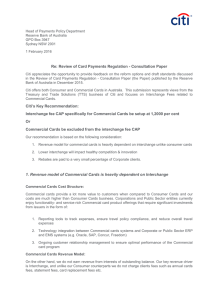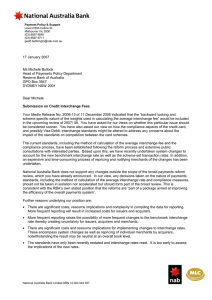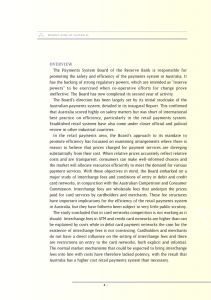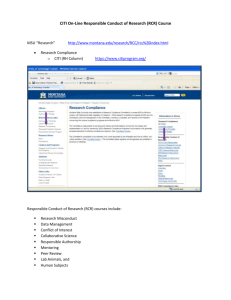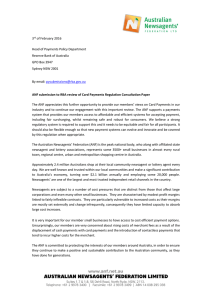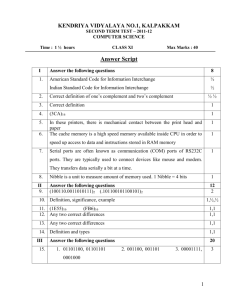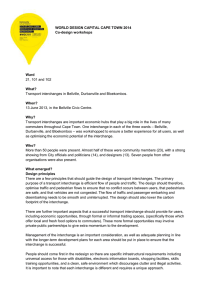DOC 50K - Reserve Bank of Australia
advertisement
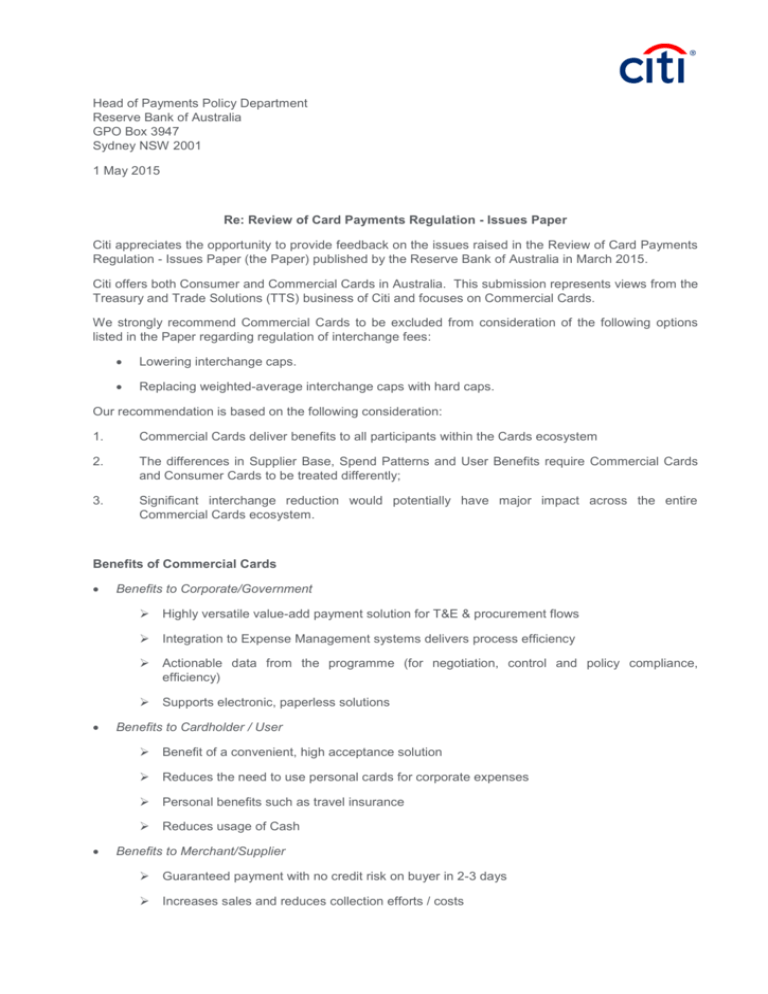
Head of Payments Policy Department Reserve Bank of Australia GPO Box 3947 Sydney NSW 2001 1 May 2015 Re: Review of Card Payments Regulation - Issues Paper Citi appreciates the opportunity to provide feedback on the issues raised in the Review of Card Payments Regulation - Issues Paper (the Paper) published by the Reserve Bank of Australia in March 2015. Citi offers both Consumer and Commercial Cards in Australia. This submission represents views from the Treasury and Trade Solutions (TTS) business of Citi and focuses on Commercial Cards. We strongly recommend Commercial Cards to be excluded from consideration of the following options listed in the Paper regarding regulation of interchange fees: Lowering interchange caps. Replacing weighted-average interchange caps with hard caps. Our recommendation is based on the following consideration: 1. Commercial Cards deliver benefits to all participants within the Cards ecosystem 2. The differences in Supplier Base, Spend Patterns and User Benefits require Commercial Cards and Consumer Cards to be treated differently; 3. Significant interchange reduction would potentially have major impact across the entire Commercial Cards ecosystem. Benefits of Commercial Cards Benefits to Corporate/Government Highly versatile value-add payment solution for T&E & procurement flows Integration to Expense Management systems delivers process efficiency Actionable data from the programme (for negotiation, control and policy compliance, efficiency) Supports electronic, paperless solutions Benefits to Cardholder / User Benefit of a convenient, high acceptance solution Reduces the need to use personal cards for corporate expenses Personal benefits such as travel insurance Reduces usage of Cash Benefits to Merchant/Supplier Guaranteed payment with no credit risk on buyer in 2-3 days Increases sales and reduces collection efforts / costs Avoids the costs of handling cash Data Integration delivers processing efficiency Commercial Cards are different from Consumer Cards Different Supplier Base Selection and Commercials Corporations/Governments are both clients of Commercial and Acceptors/Merchants of Commercial Cards and are fully aware of costs / economics of these instruments and prefer to use them. For example, purchasing card use is generating cost savings of $74 per transaction when compared to the traditional purchase-order driven acquisition process. (based on respondent-reported administrative cost savings. RPMG, 2012 Purchasing Card Benchmark Survey) Majority of spend on commercial cards (70-80%) is done under negotiated supplier agreements and costs are consciously built into those pricing negotiations Commercial Cards are a corporate payment vehicle for Business to Business purchases; Individuals are users on behalf of Corporations. Different Spend patterns Spend categories are different compared to Consumer Cards : Commercial Cards are used principally for Travel and Entertainment Spend (airfares, hotels, restaurants etc) or Business to Business Sales, while Consumer Cards are used in Supermarkets, Clothing Retailers, Dept Stores etc Spend characteristics are also very different : e.g. higher International usage Different Benefits / Value Streamlines procurement process for Corporations and Merchants vs. Consumer benefits of convenience and credit Strong value of data to all parties in the ecosystem: Buyers use it to ensure compliance with corporate policy / negotiated supplier agreements. Suppliers use it for processing efficiency. Deeper integration to Expense Management systems allowing automation of complex Corporate processes Impact of a Significant Reduction in Commercial Interchange Market structure implications Low interchange rates will expose card providers to uncertain economics related to uncontrollable factors like interest rates, credit environment, 3rd party fraud, etc. Low economics will cause some commercial card providers to exit the market, leading to consolidation and less competition in the market Significantly reduced investment in innovation will slow previously seen efficiency improvements Potential for a return to cash transactions with higher costs for merchants and a greater “black economy” risk. Impact on Merchants Reduction in immediacy of payments will lead to cash flow issues for suppliers on traditional, higher cost sources of financing especially for small businesses e.g. factoring or overdrafts Increase in operational costs for collections, reconciliation, credit losses and fraud risk. It costs 37% less for a supplier to handle a $500 card transaction versus cheque or EFT payments. (as per MasterCard and Kaiser Associates, Commercial Card Acceptance Cost-Benefit Study, November 2012) Impact on Corporate and Government buyers Efficiency agenda of Corporates and Government impacted by loss of information/integration Potential introduction of fees to corporations. Explicit costs will prevent adoption of cards as an efficiency tool Employees compelled to use their own cards for corporate spend Reduction in non-card benefits e.g. travel insurance In summary Citi’s view is that most of the issues highlighted in the Paper are not representative of the commercial cards community and therefore commercial cards should be excluded from the interchange fees hard cap or lower interchange consideration. We look forward to the opportunity to discuss our submission with RBA. Yours sincerely, Susan Yang Head of Cards and Trade Australia and New Zealand Treasury & Trade Solutions Citi
